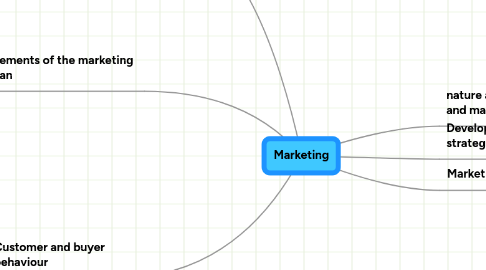
1. Elements of the marketing plan
1.1. Situational analysis including SWOT analysis and product lifecycle
1.2. establishing market objectives
1.3. identifying target market
1.4. developing marketing strategies
1.5. implementation, monitoring and controlling
1.5.1. developing a financial forecast
1.5.2. comparing actual and planned results
1.5.3. revising the marketing strategy
2. Customer and buyer behaviour
2.1. types of customers
2.1.1. people
2.1.2. households
2.1.3. firms
2.1.4. educational institutions
2.1.5. governments
2.1.6. clubs and societies
2.1.7. religious organisations
2.2. the buying process - buyers and users
2.3. factors influencing customer choice
2.3.1. psychological
2.3.2. sociocultural
2.3.3. economic
2.3.4. government
3. Ethical and legal aspects
3.1. environmentally responsible products
3.2. other issues
3.2.1. creation of needs
3.2.2. impacts of retail developments
3.2.3. sugging
3.3. roles of consumer laws in dealing with
3.3.1. deceptive and misleading advertising
3.3.2. price discrimintation
3.3.3. implied conditions
3.3.4. warranties
3.3.5. resale price maintenance
4. nature and role of markets and marketing
4.1. the role of marketing in the firm and in society
4.2. types of markets
4.2.1. resource
4.2.2. industrial
4.2.3. intermediate
4.2.4. consumer
4.2.5. mass
4.2.6. niche
4.3. production-selling-market orientation
4.4. the marketing concept
4.4.1. customer orientation
4.4.2. relationship marketing
4.5. marketing planning process
5. Market research process
5.1. determining information needs
5.2. data collection
5.3. data analysis and intepretation
6. Developing marketing strategies
6.1. market segmentation and product differentiation
6.2. Product and service
6.2.1. positioning
6.2.2. branding
6.2.3. packaging
6.3. Price
6.3.1. pricing methods - cost, market and competition based
6.3.2. pricing strategies
6.3.2.1. skimming
6.3.2.2. penetration
6.3.2.3. loss leaders
6.3.2.4. price points
6.3.3. price and quality interaction
6.4. promotion
6.4.1. elements of them promotion mix
6.4.2. the communication process - opinion leaders and word of mouth
6.5. Place / distribution
6.5.1. distribution channels and intermediaries
6.5.2. channel choice - intensive, selective, exclusive
6.5.3. physical distribution issues - transport, warehousing, inventory
6.5.4. environmental effecrs on distribution - technology, local government
